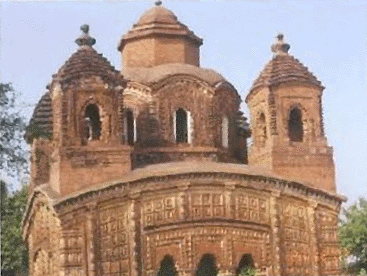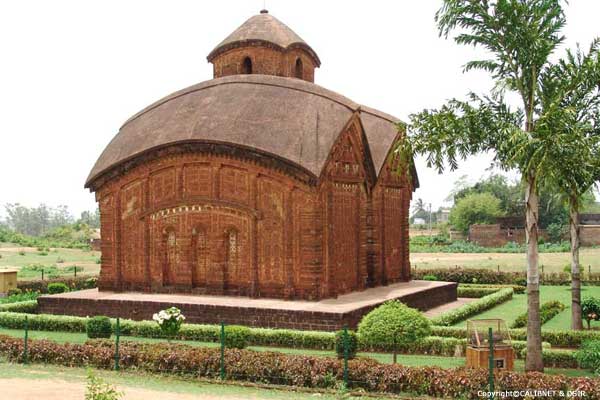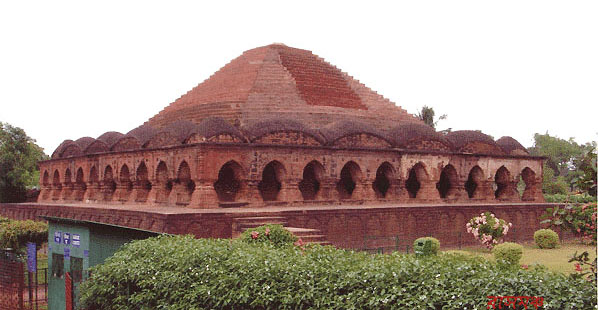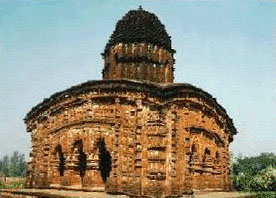The Temples of Bishnupur
BY: SUN STAFF

Oct 9, WEST BENGAL, INDIA (SUN) — Part one of a two-part archive of temple sites in Bishnupur, West Bengal, compiled by Saurab Basu.
Bishnupur, formerly known as MallaBhum, is famously known as the temple town of West Bengal for its architecturally exclusive temples, built by the Malla Rulers from AD 695 onwards. The town remained as the capital of MallaBhum, ranging as a territory containing the entire of the Bankura District and extending up to a quantitative part of today’s districts of Bardhamman and Midnapore. Any and every visitor to Bishnupur is sure to be stunned by the exquisite workmanship and architectural elegance of these historic creations. Continued patronage of the Archeological Survey Of India has made it possible for these structures to retain their lost glory, and recent illuminating additions, have added a new spirit to the entire arena.
Primarily known for its very high count of temples of extensive dignity and large tanks, Bishnupur offers the essence of a typical and profound urban complex of Bengal, which witnessed the grandeur and radiance its earlier years.
Raghunatha is known to have been the Adi Malla, or the founder of the MALLA Dynasty, after being established as the most powerful wrestler of the Kingdom. However, the Kingdom attained distinction from the time of Bir Hambir, the best known among all Malla Rulers. Although he originated as an iniquitous ruler, he later transformed into a gracious personality under the influence of a prominent and intellectual scholar named Srinivas Acharya.

Keshta-raya Temple
Jor-bangla / Keshta-raya Temple
A temple formed on the combination of two temple, is what depicts the true style of the Jor-Bangla architecture. Two such temples are found in Bishnupur, but only one of them remains in a preserved state. The second one is in ruins. The former and conserved one is the Jor-Bangla or Keshta-Raya Temple, and the other one known as Mahaprabhu temple.
The Keshta-Raya Temple is famous for its structural configuration and exclusive terracotta sculptures. According to the dilapidated inscriptional records, the temple is said to have been erected by Raghunatha Singha in 1655 AD. The structural pattern is unique in itself. It resembles the union of two hut-like structures, having two angled roofs combined to form a single architecture, installed with a char-chala tower on the crown.
Facing the southward direction, the temple has a base-platform measuring 11.8 m in length and 11.7 m in breadth, the stature being 10.7 m. The temple has some of the most exquisite terracotta works on all three sides of the porch facades. Except the stucco Shadbhuja (Six-Handed) figure of Sri Chaitanya (not worshipped nowadays), there is no other image or décor found inside the temple. Outer terracotta panels depict scenes from the Ramayana and the Mahabharata, the Krishna-Lila and other social themes. Exceptionally ornamented terracotta art places this temple high among all Bishnupur Temples.
The Mahaprabhu temple, as mentioned earlier, is in the Jor-Bangla group. It stands out to be probably constructed in 1734-35 AD, during the rule of Gopala Singha.

Ras Manch Temple
Ras Mancha
This monument of exceptional character was erected by Bir Hambir, the most renowned among the Malla Kings. The structure of picturesque beauty and structural formulation is considered a distinctive construction. The Rasa-Mancha has a combinational architectural composition, with a pyramid like get-up on a traditional Bengal Temple design. The massive structure is thought to have been built in the years between 1557-1600 A.D. It has a pyramidal summit, based upon a roomy Laterite platform. The internal sanctum of the shrine is enclosed by three successive circumambulatory galleries and crowned by a colossal pyramidal roof above. The square foundation is 1.5m high, each side of which measures 24.5m long and rises to a height of about 11m to reach a level roof above.
The primary purpose behind the erection of this colossal structure was the arrangement of the ‘Ras’ festival, when every image, large or small, in the form of Deities was brought here from each and every neighboring shrine or temple. They were arranged for display to every individual during this occasion. This ritual was in practice during the Malla Rule and now stands obsolete, excepting the grandeur and glory of those days that the Ras-Mancha reminds one of.
Maintenance of this historic masterpiece is being conducted dedicatedly by the ASI, providing illumination facilities and conserving the fragile terracotta craftsmanship that as exercised on each and every designed bricks and walls of the Ras-Mancha. The ASI charges Rs.5/- per head, for entry and maintenance of the Ras-Mancha, Jor-Bangla and Shyam-Ray Temples. (Tickets are needed to be purchased at the entrance of the Ras-Mancha, and the same remains valid for the rest too. Only a one-time expense of Rs.5/- is necessary.)
Ma Chinnamasta Temple
One of the most renowned and lively Deities in all Bishnupur is the Chinnamasta Mata. The temple is almost 100 years old and newly renovated. The specification of this Deity resembling the Goddess of Power is that ‘It depicts the goddess without her head, or rather she is seen to carry her head on one of her 12 arms’. ‘Chinnamasta’, a word in Bengali, means, ‘With the head separated’. This temple lies on the way to the Jor-Mandir group of Temples via the Dalmadal Cannon/Gun. Regular offerings and worship are made to the divine being by hundreds of devotees. The Deity has been carved out of Red Desert Sandstone, and the entire complex was set up by one of the devotees of the goddess, from Midnapore.

Radha Madhava Temple
Radha Madhava Temple
Located to the North of the Lal-Bandh stands the grand Radha Madhava Temple. It depicts the typical ‘Eka-Ratna’ Style of temple Architecture. The temple was built in AD 1737 by one of the spouses of Bir Singha, Siramanidevi.
The temple has a square plan, and measures app. 11.1 m and 9.2 m in height. There are three arches on the walls of the portal, approaching the entry of the temple. The rows of birds, animals and epical scenes can be found on a splendorous display, parallel to the platform. On the side or edges and the bottom region of the cornice there exist elaborate and descriptive sculptural reliefs, displayed in two rows. Scenes from the Krishna-Lila are located on the sides of the arches and the pillars are also embroidered with relief beautification dealing with diverse themes. There is a ‘do-chala’ ‘Bhog-Mandapa’, positioned near the temple itself. This construction is unique because no other do-chala structures are located anywhere else in Bishnupur. The temple complex is well maintained and conserved by the ASI., and has a lush green environ surrounding the premises.
Shyama-raya Temple
This temple is the best example of the ‘Pancha-Ratna’ type. One of the prides of Bishnupur in terms of its architectural pattern, Shyama-Raya temple attains a place in the highest prioritized monuments of the Archaeological Survey of India (ASI). The post-conservation state of this temple takes us back to the splendor and glory it carried during the early years of establishment. Raghunatha Singha built this exclusive temple in the year 1643 AD. Exclusive and exquisite in terms of the high-class terracotta beautification, this temple is extraordinary in its structural configuration.
The terracotta sculptures engraved on the walls and edges or reliefs depict various scenes from epics like the Ramayana, Mahabharata, Krishna-Lila, etc. Other topics include the royal hunting scenes. The cornices are carved with friezes showing musicians and lively dancers. The panels with scroll works depicting Radha-Krishna figures appear truly lively. Because of the five towers, the pattern is commonly considered to belong to the ‘Ratna-Chuda’ type.
The well decorated porches and plinth depict the true display of the splendorous craftsmanship practiced during those early periods. Built entirely in brick, this temple is quite massive in shape and thus we can imagine that crafting the number of small and large sculptures needed to design the entire structure must have been a painstaking job, requiring prolonged concentration and devoted dedication. Each side of the temple measures about 11.4 m and is 10.7 m in height. Detailed specifications in the terracotta sculptures, for instance depicting the ‘Rasamandala’ in the Krishna-Lila or the dancing Gopis, is really astonishing.
Mrinmoyi Mata Temple
The Deity is known to be more than a thousand years old. Foundation inscriptions suggest that the goddess was first enshrined in the year 997 AD by the then Malla King JagatMall. the location of this temple is just near the remains of what used to be the Royal Palace. It is said that this Deity was hidden beneath the present shrine and the king, upon being divinely instructed, conserved the divinity and appropriated her shrine by establishing the temple. The temple has undergone numerous renovations since that time to retain its present state.
